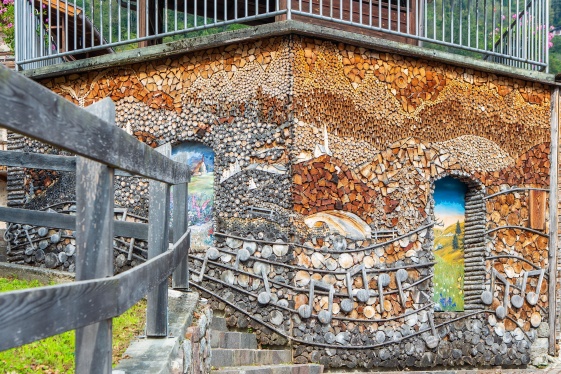
I borghi più belli d'Italia
The goal of our Club, which was not created merely as an integrated tourist promotional operation, is to guarantee - through protection, restoration, promotion and utilization - the preservation of a great heritage of monuments and memories that would otherwise be irretrievably lost. http://www.borghitalia.it/
Italian little Italies: Troina, first Norman capital of Sicily
Troina is a very ancient city. The first settlements in the territory go up again to the prehistoric period while the first nucleus of the inhabited center goes up again to the IV century to. C. Many studious identify Troina with the ancient Engyon, center of the pre-Hellenic temple devoted to the cult of the Goddesses Mothers. Because of its geogr...
Italian little Italies: Caramanico Terme, the thaumaturgic waters of Maiella
From the woods of Mt. Maiella, the Borgo of Caramanico looks like “a melt of Acropolis”, as city planners call high middle ages settlements that have this kind of structure. The village was founded in Longobard period on a promontory at the confluence of two rivers, the Orfento and the Orta. The main path develops on the line of the ridge, with ato...
Italian little Italies: Vigoleno, a patrol path through the countryside of Piacenza
Vigoleno is a village-castle where everything seems to be, despite the narrowness of the space, a labyrinth in which you never know where you are, whether in the medieval village or in the castle, so much so that one is mirrored in the other. Vigoleno has a great evocative power. What impresses most, looking from the plain, are the wide expanses of...
Italian little Italies: Gradisca d'Isonzo, a frontier baroque town
Gradisca’s architectural structure has been influenced by four historic periods: the Venetian period (15th century), the Austrian period (17th century), the Habsburg period (19th century) and the Italian period (20th century). The borgo was born as a bulwark against the frequent and devastating Turkish incursions, it was built by Venetian architect...
Italian little Italies: Cisternino, the dazzling kasba of the Itria Valley
There is a suggestive atmosphere in the borgo, among houses, tiny streets and courtyards. The Borgo is an example of “spontaneous architecture” designed not by architects following a preestablished plan, but rather by human relations to be fit together, among white painted houses and narrow streets, tiny courtyards and outside stairs, arches and fl...
Italian little Italies: Frontino, a corner of paradise in Montefeltro
The castle is perched on a cliff overlooking the Mutino valley. High walls, towers, squares, paved streets, flowers and plants along the streets welcome the visitor. The silence, broken only by the flock of century-old oaks and the light mountain air draw the picture of a landscape of the soul, where reality becomes almost fantastic, recalling ima...
Italian little Italies: Atrani, A brief smile of houses on the coast
The beach that surrounds Atrani is the wonderful scenery that surrounds the Borgo that, with its tiny houses built on top one of the other, looks like a nativity scene, especially at night with the glimmering lights. In daytime, the tiny streets seem to disappear behind the houses only to reappear suddenly, widening into a small square, where the l...
Italian little Italies: Bevagna, Artisanal masters
Bevagna has preserved virtually intact its medieval urban structure, which for the most part follows the plan of the ancient Roman town. You can start visiting this Borgo from Piazza Silvestri, with its irregular structure that will show you how harmony can be created from an apparent chaos of styles, histories eras. This is one of the most magnifi...
Italian little Italies: Monforte d'Alba, UNESCO heritage in Piedmont's wine landscapes
The heart of the borgo is the residence of the Scarampi Marquises, located next to the square in which the Auditorium Horszowski was built and where the Bell Tower and the two Confraternities of St. Elizabeth and St. Augustine stand. Nothing remains of the original castle of Monforte, documented in the 11th century. On the site of the previous cast...
Italian little Italies: Pietrapertosa, between the rocks and the sky
The Borgo rises at the end of a road full of hairpin bends, a landscape made of intended and sharp pinnacles, sloping rocks and ridges touching the sky, that reminds a Northern Italy Dolomite scenery but in the very Southern Italy. Pietrapertosa is inside the Gallipoli Cognato and Dolomites of Lucania Park, characterized by the typical fantastic sa...
Italian little Italies: Mezzano, scattered rural signs
Mezzano lies at the foot of the famous Dolomites Mountains called “Pale di San Martino”, recently recognized by UNESCO as world heritage. The centre of Mezzano is made of an almost continuous sequence of old rural, residential stone and wood buildings that follow the ancient way to Feltre. There are no monumental buildings in this borgo, but it can...
Italian little Italies: Subiaco, the first monastery of St. Benedict
The only remaining monastery of the thirteen founded by St. Benedict of Norcia in the Aniene valley is that of St. Scholastica, the oldest in the world of the Benedictine order. The structure develops around three cloisters: the Cosmatesque cloister (13th century), the Gothic one (14th century) and the Renaissance one (16th-17th century). The Roman...














